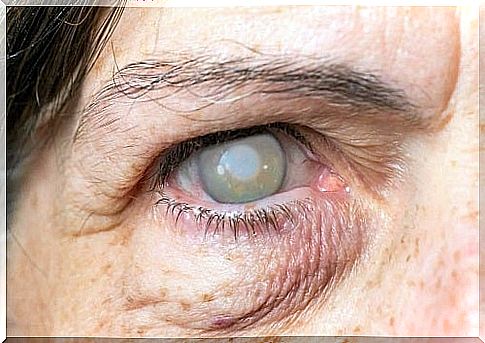Symptoms And Causes Of Vision Loss

There is no doubt, sight is one of the senses we rely on the most. Therefore, vision loss is a serious problem that dramatically changes your life. Want to find out the symptoms and causes of vision loss? Read on and we will explain everything to you!
First, for a decrease in visual acuity, at least one of the organs involved must be affected. In this sense, partial or total blindness will occur when there is a problem with the cornea, lens, retina or optic nerve.
Causes of partial vision loss
When we talk about partial blindness, we refer to those people who, despite having suffered a considerable decrease in visual acuity, are still able to distinguish certain shapes, lights and shadows. Therefore, there is no complete loss of sense, but individuals can no longer rely on their sight as most people do. Depending on its cause, this type of blindness can be chronic or acute.
Let’s see what are the most common causes of partial vision loss.

Any lesion that appears on the surface of a tissue will generate a scar. The cornea is no exception. This scar eliminates the transparency of the cornea, which prevents light from reaching the retina. This causes a major decrease in visual acuity.
Corneal injuries can have a variety of causes, from severe infections to direct trauma. Any stimulus that can damage the corneal cells to a considerable depth will generate partial blindness.
The affected visual field varies depending on the location and size of the scar. In this sense, there is no specific presentation model. However, the following symptoms may occur:
One of the most common causes of partial blindness is cataracts. They cause opacity of the lens, which is the main means of refraction of the eye. Opacities prevent light from reaching the retina properly, causing partial vision loss.
Most cases occur due to lens degeneration or injury. According to various studies, cataracts are the cause of 47.9% of cases of vision loss in older adults.
The main symptoms reported by people with cataracts are blurred, opaque or blurred vision, blurred colors and inability to see well at night. Also, some lights look very bright or have a halo around them. In addition, double vision also appears.
The retina is the part of the eye responsible for transmitting light signals directed by the lens, so that the brain processes them. Therefore, naturally, any damage to it can cause vision loss.
In most cases, defective capillaries cause retinal problems. These capillaries filter fluid from the tissue. Thus, among the most common causes we can find the following:
There is another type of retinal injury that is not related to the presence of fluids. An example of this is macular degeneration, in which the center of the retina begins to deteriorate, generating a blurred vision or a blind spot in the visual field.
Also, many infections with fungi, parasites or bacteria can seriously damage the retina. This is the case with ocular toxoplasmosis, which is very common in immunosuppressed people.
The optic nerve is responsible for transmitting all the information captured by the retina to the brain. Therefore, it is a crucial part of the body’s ability to see. Problems with this structure affect one or more fields of view.
In most cases, the problems are caused by glaucoma. This is a common disease that causes an increase in intraocular pressure that affects the nerve. The optic nerve becomes unable to transmit signals properly, which makes it difficult to see.
However, there are a number of other conditions that can cause partial blindness by affecting the optic nerve, such as optic neuritis or nerve inflammation. In addition, the indirect effects of cerebral vascular events (CVE) or central nervous system tumors also affect vision.
It is important to clarify that the symptoms of optic nerve damage may vary depending on their etiology. However, people often experience rapid vision loss, reddish saturation in one or more fields of vision, double vision, and eye pain.

Causes of total vision loss
When the trauma is very severe and affects the entire cornea, the individual may have complete loss of vision. One of the most common causes of this type of injury is chemical burns.
But not only corneal lesions are able to affect visual acuity. A penetrating or blunt lesion of the head or eyeball can damage the optic nerve and retina.
We mentioned partial detachment of the retina as a cause of partial blindness. If not treated in time, it can progress to a complete detachment, the vision being completely lost.
In most cases, complete detachment of the retina occurs due to the presence of fluid in the back of the retina. The fluid separates the tissue of the eyeball, interrupting the blood supply, which can cause ischemia and cell death.
Although the disease may be asymptomatic and painless at first, some people may experience the following symptoms:
Diabetic retinopathy is one of the complications of diabetes. It affects the retinal capillaries that filter the fluids and promotes the deposition of substances. In addition, it can block certain healthy blood vessels.
In the early stages of the disease, partial blindness may occur. However, if nothing is done to stop the progression of the condition, it causes complete loss of vision. In the last stage, new blood vessels with very thin walls are generated to try to properly irrigate the tissue. These new capillaries are prone to spontaneous rupture and the generation of retinal hemorrhage.
A rare cause of vision loss is endophthalmitis. This is an infection inside the eye and should always be considered a medical emergency.
External microorganisms can enter the eyes after surgery or eye damage and can cause this infection. The disease can also be caused by an internal septic infection that has affected the eye.
Symptoms experienced by people with endophthalmitis include severe eye pain with redness of the eyes and the appearance of a yellow, white or purulent discharge inside the eyeball. The eyelids become inflamed.
All blood vessels in the body are prone to blockages. When blockages occur in the blood vessels of the retina or optic nerve, the individual experiences a painless loss of vision.
If the affected blood vessel is the central retinal artery or the optic nerve artery, there will be an inadequate blood supply to the tissues. This will result in insufficient oxygen supply, which could cause them to swell and become permanently damaged.
When vascular occlusion affects the central vein of the retina, there will be no adequate drainage of blood. This will cause the water to collect, ie an excessive accumulation of fluid in the tissues, which will lead to blindness.

When should I go to the doctor to find out the causes of vision loss?
Loss of vision, in whole or in part, should always be considered a medical emergency. In many cases, it can be painless and may seem temporary. However, the lack of pain does not indicate that it is less severe and should therefore never be ignored.
For this reason, it is essential to go to a specialist as soon as possible so that he can perform the relevant tests and arrive at an accurate diagnosis. Many causes of vision loss provide only a short period of time before the damage is irreversible.
It is important to clarify that when vision loss cannot be reversed, a lifestyle change is needed. Fortunately, today there are many ways in which people with visual impairments can carry out their daily activities without any inconvenience.









